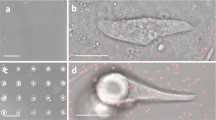Abstract
Tissue microenvironments can regulate cell behavior by imposing physical restrictions on their geometry and size. An example of these phenomena is cardiac morphogenesis, where morphometric changes in the heart are concurrent with changes in the size, shape, and cytoskeleton of ventricular myocytes. In this study, we asked how myocytes adapt their size, shape, and intracellular architecture when spatially confined in vitro. To answer this question, we used microcontact printing to physically constrain neonatal rat ventricular myocytes on fibronectin islands in culture. The myocytes spread and assumed the shape of the islands and reorganized their cytoskeleton in response to the geometric cues in the extracellular matrix. Cytoskeletal architecture is variable, where myocytes cultured on rectangular islands of lower aspect ratios (length to width ratio) were observed to assemble a multiaxial myofibrillar arrangement; myocytes cultured on rectangles of aspect ratios approaching those observed in vivo had a uniaxial orientation of their myofibrils. Using confocal and atomic force microscopy, we made precise measurements of myocyte volume over a range of cell shapes with approximately equal surface areas. When myocytes are cultured on islands of variable shape but the same surface area, their size is conserved despite the changes in cytoskeletal architecture. Our data suggest that the internal cytoskeletal architecture of the cell is dependent on extracellular boundary conditions while overall cell size is not, suggesting a growth control mechanism independent of the cytoskeleton and cell geometry.




Similar content being viewed by others
References
Bray, M. A.; Sheehy, S. P.; Parker, K. K. Sarcomere alignment is regulated by myocyte shape. Cell Motility Cytoskel. 65(8): 641–651; 2008. doi:10.1002/cm.20290.
Campbell, S. E.; Gerdes, A. M.; Smith, T. D. Comparison of regional differences in cardiac myocyte dimensions in rats, hamsters, and guinea pigs. Anat. Rec. 219(1): 53–59; 1987. doi:10.1002/ar.1092190110.
Chen, C. S.; Mrksich, M.; Huang, S.; Whitesides, G. M.; Ingber, D. E. Geometric control of cell life and death. Science. 276: 1425–1428; 1997. doi:10.1126/science.276.5317.1425.
Delbridge, L. M.; Satoh, H.; Yuan, W.; Bassani, J. W.; Qi, M.; Ginsburg, K. S.; Samarel, A. M.; Bers, D. M. Cardiac myocyte volume, Ca2+ fluxes, and sarcoplasmic reticulum loading in pressure-overload hypertrophy. Am. J. Phys-Heart Circ. Phys. 272(5): 2425–2435; 1997.
Engler, A. J.; Carag-Krieger, C.; Johnson, C. P.; Raab, M.; Tang, H. Y.; Speicher, D. W.; Sanger, J. W.; Sanger, J. M.; Discher, D. E. Embryonic cardiomyocytes beat best on a matrix with heart-like elasticity: scar-like rigidity inhibits beating. J. Cell Sci. 121(Pt 22): 3794–3802; 2008. doi:10.1242/jcs.029678.
Gerdes, A. M. Cardiac myocyte remodeling in hypertrophy and progression to failure. J. Card. Fail. 8: S264–S268; 2002. doi:10.1054/jcaf.2002.129280.
Gerdes, A. M.; Capasso, J. M. Structural remodeling and mechanical dysfunction of cardiac myocytes in heart failure. J. Mol. Cell Cardiol. 27: 849–856; 1995. doi:10.1016/0022-2828(95)90000-4.
Glantz, S. A. Primer of Biostatistics. 5th ed. McGraw Hill, New York2002.
Huang, S.; Chen, C. S.; Ingber, D. E. Control of cyclin D1, p27(Kip1), and cell cycle progression in human capillary endothelial cells by cell shape and cytoskeletal tension. Mol. Biol. Cell. 9: 3179–3193; 1998.
Jacot, J. G.; McCulloch, A. D.; Omens, J. H. Substrate stiffness affects the functional maturation of neonatal rat ventricular myocytes. Biophys. J. 95(7): 3479–3487; 2008. doi:10.1529/biophysj.107.124545.
Lammerding, J.; Kamm, R. D.; Lee, R. T. Mechanotransduction in cardiac myocytes. Ann. N.Y. Acad. Sci. 1015: 53–70; 2004. doi:10.1196/annals.1302.005.
LeDuc, P.; Bellin, R. Nanoscale intracellular organization and functional architecture mediating cellular behavior. Ann. Biomed. Eng. 34(1): 102–113. (12); 2006.
Lindner, M.; Bohle, T.; Beuckelmann, D. J. Ca2+-handling in heart failure—a review focusing on Ca2+ sparks. Basic Res. Cardiol. 97(Suppl 1): I79–182; 2002a. doi:10.1007/s003950200034.
Lindner, M.; Brandt, M. C.; Sauer, H.; Hescheler, J.; Bohle, T.; Beuckelmann, D. J. Calcium sparks in human ventricular cardiomyocytes from patients with terminal heart failure. Cell Calcium. 31: 175–182; 2002b. doi:10.1054/ceca.2002.0272.
Onodera, T.; Tamura, T.; Said, S.; McCune, S. A.; Gerdes, A. M. Maladaptive remodeling of cardiac myocyte shape begins long before failure in hypertension. Hypertension. 32: 753–757; 1998.
Parker, K. K.; Brock, A. L.; Brangwynne, C.; Mannix, R. J.; Wang, N.; Ostuni, E.; Geisse, N. A.; Adams, J. C.; Whitesides, G. M.; Ingber, D. E. Directional control of lamellipodia extension by constraining cell shape and orienting cell tractional forces. FASEB J. 16: 1195–1204; 2002. doi:10.1096/fj.02-0038com.
Parker, K. K.; Tan, J.; Chen, C. S.; Tung, L. Myofibrillar architecture in engineered cardiac myocytes. Circ. Res. 103: 340–342; 2008. doi:10.1161/CIRCRESAHA.108.182469.
Tan, J. L.; Liu, W.; Nelson, C. M.; Raghavan, S.; Chen, C. S. Simple approach to micropattern cells on common culture substrates by tuning substrate wettability. Tissue Eng. 10: 865–872; 2004. doi:10.1089/1076327041348365.
Walters, D. A.; Cleveland, J. P.; Thomson, N. H.; Hansma, P. K.; Wendman, M. A.; Gurley, G.; Elings, V. Short cantilevers for atomic force microscopy. Rev. Sci. Instrum. 67: 3583; 1996. doi:10.1063/1.1147177.
Shorofsky, S. R.; Aggarwal, R.; Corretti, M.; Baffa, J. M.; Strum, J. M.; Al-Seikhan, B. A.; Kobayashi, Y. M.; Jones, L. R.; Wier, W. G.; Balke, C. W. Cellular mechanisms of altered contractility in the hypertrophied heart: big hearts, big sparks. Circ. Res. 84: 424–434; 1999.
Acknowledgment
We are grateful to the Harvard Center for Nanoscale Systems for use of their facilities.
Sources of Funding
Harvard Materials Research Science and Engineering Center (MRSEC) sponsored by the National Science Foundation and the National Institutes of Health (1 R01 HL079126-01A2).
Author information
Authors and Affiliations
Corresponding author
Additional information
Editor: J. Denry Sato
Rights and permissions
About this article
Cite this article
Geisse, N.A., Sheehy, S.P. & Parker, K.K. Control of myocyte remodeling in vitro with engineered substrates. In Vitro Cell.Dev.Biol.-Animal 45, 343–350 (2009). https://doi.org/10.1007/s11626-009-9182-9
Received:
Accepted:
Published:
Issue Date:
DOI: https://doi.org/10.1007/s11626-009-9182-9




